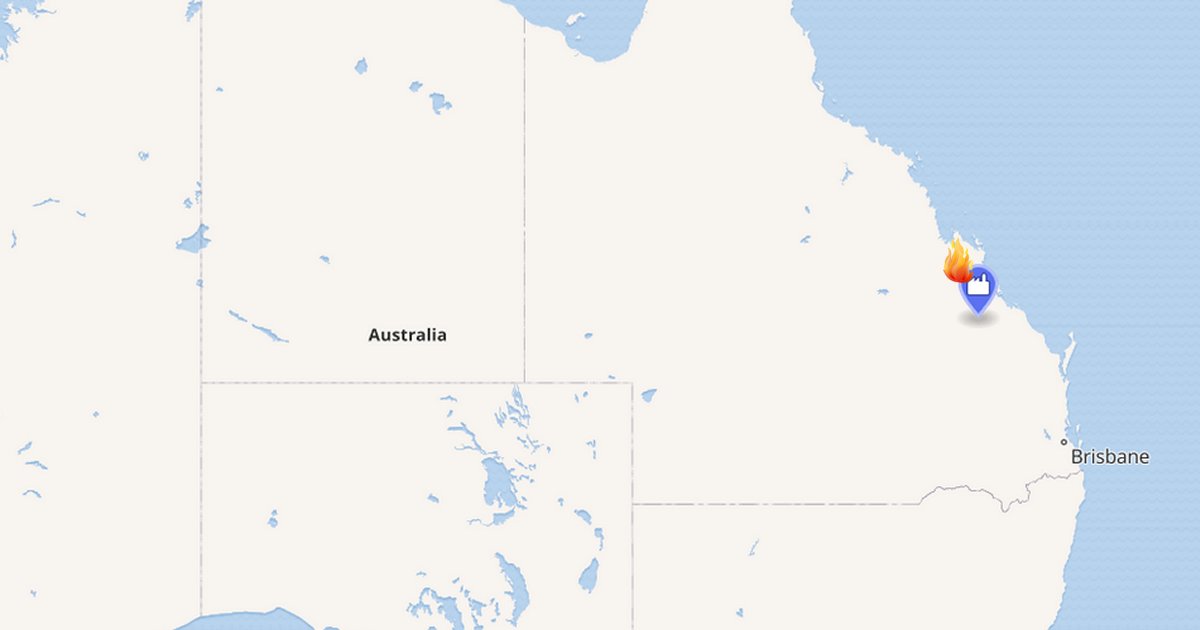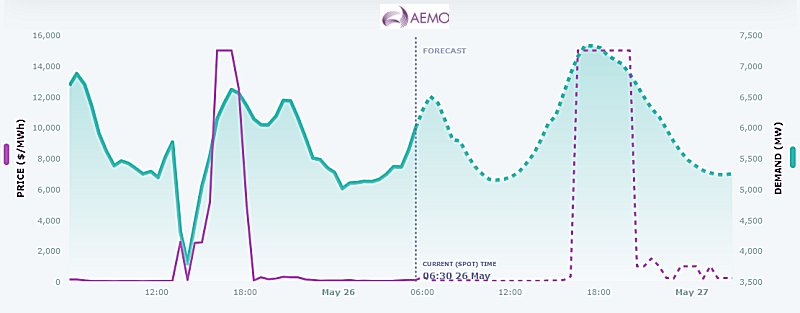
Coal power in Australia copped yet another blow yesterday, with a fire/explosion occurring at Callide Power Station in Queensland.
Callide Power Station is located near Biloela in Central Queensland and is comprised of two black coal fired power plants, Callide B and C; each with two generating units. Callide B has been operating since 1988 and Callide C since 2001. Combined, their capacity is around 1.5GW.
At approximately 1.45pm yesterday, a fire occurred in one of the turbine halls at the facility. The three units that were generating at the time (one was undergoing maintenance) went offline, the power station was evacuated and emergency services called in. Thankfully, no-one was injured.
The incident had a knock-on effect, tripping other generation and transmission infrastructure including Stanwell and Gladstone power stations.
Energex reported a widespread blackouts from the Gold Coast to Caboolture affecting 375,000 of its customers. Ergon Energy noted outages affecting “tens of thousands” of its customers across regional Queensland. Power was restored to many customers by late afternoon, but Queenslanders were asked to conserve energy into the evening.
The cause of the fire is still unknown at this stage and staff are yet to be able to re-enter the plant to start an investigation, so it’s not clear how long Callide will be out of action for.
In addition to the initial chaos caused by the event, it also played havoc with wholesale electricity spot prices in Queensland, which jumped from $50/MWh just prior to the maximum $15,000/MWh between 5pm and 6pm yesterday. At 6.30am this morning, the spot price was just north of $100/MWh, but it’s forecast to go sky-high again this evening.
Greens : Kill Coal!
The Greens have called for the Australian Energy Market Operator (AEMO) and the Australian Energy Regulator to launch a safety and reliability inquiry into all Australia’s coal-fired power stations, and renewed its call for all coal power in Australia to be shuttered by 2030.
“The explosion at the Callide coal burning power station and widespread power outages across Queensland provide more proof that coal power is dangerous and has no place in a modern energy system,” the party stated.
Senator Matt Canavan: More Coal!
As expected, Senator Matt Canavan contributed his wisdom twisted logic, stating:
“We have let our energy system become so vulnerable that one explosion takes down the power for thousands of people. Build modern coal fired power stations so we can keep the lights on!”
And just to ensure his message was received, he posted shortly after:
“We need more coal fired power to keep the lights on!”
One of Australia’s newer coal power stations, Callide experienced multiple breakdowns in 2020. On a related note, a report from The Australia Institute published last year found Queensland’s gas and coal power stations were the most unreliable of any state in the National Electricity Market (NEM).
Ronald’s Take:
“When a coal power station tries to kill itself, the kindest thing for all involved is to let it,” says SQ’s Ronald Brakels. “This doesn’t mean you shouldn’t put fires out. It doesn’t mean you shouldn’t make sure there’s enough capacity to meet demand. But when something that’s killing you kills itself, you shouldn’t knock yourself out trying to bring it back to life.”


 RSS - Posts
RSS - Posts



I wonder if any of our pumped hydro was used during this period?
It sure was used. While hydro didn’t ramp up until the blackout was ending, it managed to provide up to around 619 megawatts of power. That’s pretty much the maximum possible output for hydro in Queensland.
Wattclarity reports a “demand response” type contribution from Wivenhoe by stopping pumping and hence removing 241MW of demand; this likely would have reduced the scale of the “load shedding” blackout. https://wattclarity.com.au/articles/2021/05/25may-part5-threeevents/
Unfortunately, unlike batteries, pumped hydro can’t switch from pumping(charging) to generating (discharging) in microseconds.
Depending on how prolonged the outage at Callide C remains, I’d suggest there will be increased strain on NSW generators to step up. Fortunately, the outage has been between summer and winter. If it had happen in summer, I suspect it may have been a very different story.
Meanwhile, per the AEMO NEM Electricity Statement of Opportunities (ESOO), dated Sep 2020, expected retirements of coal-fired power generator units include:
* NSW, Liddell, _ _ _ _ _500 MW, Apr 2022 (page 121)
* NSW, Liddell, _ _ _ _1,500 MW, Apr 2023
* NSW, Vales Point B, 1,320 MW, Dec 2029
* Qld, Callide B, _ _ _ _ 700 MW, Dec 2028 (page 123)
On page 120:
“There remains a period of two years, after Liddell retires and before Snowy 2.0 is developed, when expected USE [unserved energy] exceeds the IRM [Interim Reliability Measure].”
https://aemo.com.au/energy-systems/electricity/national-electricity-market-nem/nem-forecasting-and-planning/forecasting-and-reliability/nem-electricity-statement-of-opportunities-esoo
Victoria’s Yallourn W 1,450 MW brown coal power station will close in 2028.
https://reneweconomy.com.au/energyaustralia-says-yallourn-coal-generator-to-close-early-in-2028/
All the more need for more fast response BESSs to fill the supply gap when large generators trip-out/fail, while slower response generators wake up.
https://reneweconomy.com.au/big-battery-storage-map-of-australia/
IMO, the RenewEconomy Battery Storage Map of Australia (to date) is not entirely accurate and up to date. Errors and omissions I see include:
1. “WALLEREWANG” should be spelt WALLERAWANG;
2. The Neoen BESS is NOT on the site of the former Wallerawang Power Station;
https://www.planningportal.nsw.gov.au/major-projects/project/40891
3. There’s another 500 MW BESS omitted from the map, that’s proposed by Greenspot to be on the site of the former Wallerawang Power Station.
https://www.planningportal.nsw.gov.au/major-projects/project/41221
I highlighted the errors/omissions I see to RenewEconomy via email yesterday. Hopefully they will update the map soon, and IMO, it could be a very useful information resource.
Additional Info:
Per WattClarity, the damage from the explosion and fire at the Callide C unit 4 (405 MW capacity) could mean it may be offline for a year.
https://wattclarity.com.au/articles/2021/05/25may-part4-callide-c4-tentatively-offline-for-a-year/
Mt Piper Unit 1 turbine and boiler upgrades were completed on 20 Dec 2020 and was available for service on 1 Jan 2021. Unit 1 capacity was increased from 700 MW to 730 MW. EnergyAustralia has scheduled a turbine and boiler upgrade to Mt Piper Unit 2 (700 MW capacity) from 2 Sep 2021 – see pages 03 & 04: https://www.energyaustralia.com.au/sites/default/files/2021-03/Lithgow%20CCC%20meeting%20minutes%2001032021.pdf
I wonder whether the AEMO will ask EnergyAustralia to defer the Mt Piper Unit 2 upgrade until the Callide C unit 4 is back in service.
Additional Info:
It seems Callide C Unit 4 sustained a catastrophic failure of its turbine – an unscheduled near instantaneous disassembly.
Yesterday’s AFR article by Mark Ludlow headlined “Callide C damage looked like ‘bomb going off’”, quoted CFMEU district president Shane Brunker saying that there are “holes punched in the roof and walls and the shielding of the building”, and that “there was a piece of metal in the roof. We didn’t know what it was, but it weighed 300 kilograms”.
CS Energy says Callide C Unit 4 will be out of action for up to a year. The other units at Callide B & C are expected to be back in operation by Jun 9.
Some energy experts believe the estimated $200 million repair cost for Callide C Unit 4 could result in it being closed early.
https://www.afr.com/companies/energy/callide-c-damage-looked-like-bomb-going-off-20210531-p57wnz
Gas is filling the supply gap, together with less electricity exports to the other states.
Still choking on Canavan’s logic! It is the same logic that drove statements blaming wind generation for the huge outage in S.A, when the transmission towers failed in extreme wind conditions. The common sense way to build resilience into a national energy system is to have systems that can isolate so that outages are limited in area (microgrids), rather than more centralised coal fired power generation.
Ronald – You LEGEND
“when something that’s killing you kills itself, you shouldn’t knock yourself out trying to bring it back to life.”
One of the most simplest but 100% correct statements , well done Ronald.
Coal related illnesses and deaths are brushed aside, because there is no list of order on who will die next,, If we could know who would be next to die due to coal related illnesses, I doubt we would ever burn coal again,
I Guarantee, If the next person who would die of coal related diseases was the Prime Minister, or someone in his family, Coal burning power stations would have been shut off Yesterday!!
If Australia cant keep a coal fired power plant from blowing up, it makes me rethink my view on having nuclear power stations here.
Nuclear is a dead topic now. No point even thinking about it. Too expensive, way too expensive. Too long to build.
Nuclear power stations also blow up and even more spectacularly! With long term hazards.
28 documented nuclear incidents and accidents since 1957, with the most recent one in September 2011 in France.
Estimated cost for managing these incidents/accidents amounts to about $18,517,000,000 at 2006 US dollars.
Now, what could have we done with that money?
Leverage free energy from sun and wind and more storage is the answer long term.
Many millions seem to have been spent in recent years on ‘upgrading’ the Callide generators.
According to an article published on the ABC on 28th May 2021
“the C4 unit had undergone a “major overhaul” in 2017 at a cost of “close to $50 million”.
and:
Towards the end of 2020, it was announced that ” a $60 million overhaul was being undertaken of the B1 and C4 generating units to ensure their effective operation.” A further announcement that the overhaul was completed was made at the end of December 2020..
You can read the full article here:
https://www.abc.net.au/news/2021-05-28/qld-power-station-fire-explosion-callide-blackout-overhaul/100172100
The article is a bit ‘vague’ on the details of precisely how much was spent on what, but it was claimed that the 2020 overhaul created jobs for “approximately 200 contractors and provided $6 million in flow-on benefits to the local area.
Given the number of contractors, I can understand how difficult it would be to track every last $ and cent down to the cost of a single bolt or washer, along with the costs of various safety checks, quality inspections and certifications as the work progressed.
Anyhow, it seem that the Callide plant is going to be ‘off-line’ for maybe a full year, (assuming it gets repaired rather than shut-down altogether), but there’s insufficient information at the moment for an economic evaluation to be made as to the best course of action.
If Callide remains offline during the summer peak,that could possibly tip the scales enough for outages to occur in some places, along, quite apart from any other problems that might arise with other coal generators.
Looks as though spending $50 million or so every 5 years is needed for maintenance and overhaul of generators at the relatively small Callide site, which maybe gives some clue as to cost involved in overhauling coal generators at other sites on a 5 yearly basis
Anyhow, so far as Callide is concerned, $110 million spent over the last 5 years has just gone up in smoke.
.
There were two separate failures. Callide of 700MW and *15 minutes later* a trip of everything connected to the CAVALE terminal station, which caused 2200MW(!) of generation to trip and (temporary) loss of synchronisation from the rest of the NEM.
What caused the second event? We have little idea. The Callide generator was connected to the CALVALE bus, but 15 minutes is an eternity for high voltage protection systems.
*correction 21 minutes
Wattclarity has also published a single line diagram showing what tripped and when.
https://wattclarity.com.au/articles/2021/05/sequence-of-events-on-25-may-a-very-short-partial-visual-guide/